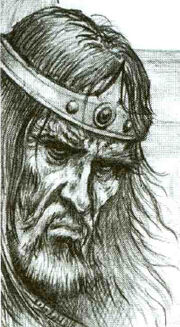Gemmera or Gemmeria was a former kingdom and later one of the provinces in the Nilfgaardian Empire. It was known for its fierce warriors, like the Gemmerian Pacifiers.[3]
Through ages, some Nordling cartographers claimed that Gemmera was the southernmost part of the Continent and that the lands below belonged to another landmass, but most of the others considered Ebbing to be the southern boundary. By the time of the Second Northern War however, these beliefs were apparently abandoned.[4]
National emblems[]
It is unknown whether Gemmerian territories before the Nilfgaardian conquest had one coat of arms at any point, marking Gemmera as a whole. At least two tribal designs were used: one with a boar head[5] and one with a horse head.[4]
The province of Gemmera had coat of arms with Great Sun in chief.[5]
Illustrations in the infobox and below have been created by Wiki editors basing on official descriptions and/or depictions.
History[]
Ancient[]
Ages ago, the coastline region of Gemmera had an elven presence, as evidenced by the Tower of the Winds.[4] In the hills, there was at least one dwarven mine, along with an ancient forge and foundry.[5]
Pre-conquest[]

A Gemmeran duke, Ponderic
Inhabited by fierce and harsh barbarous folk,[5][4] for ages had the kingdom of Gemmera been a nuisance for neighbouring countries. It is known that at least one Gemmerian invasion was aimed at the Nilfgaardian Empire during the reign of Emperor Torres.[5]
In the second half of the 12th century, Gemmera was facing increasing influences of the Empire. They were held at bay by the usurper Duke Ponderic until he was dethroned by the witcher Dragonfly of Stygga and the son of his murdered brother Woderic.[4]
Nilfgaardian province[]
Gemmera was finally subjugated in 1226[6] by Emperor Fergus var Emreis. Thirsty of its large seams of dimeritium, he gathered resources and, joined by forces of Etolia and Vicovaro, invaded the country and rooted out nearly the whole population of the rocky regions, leaving little more than wandering goat herders in some areas. After the conquest, the fiercest of Gemmerian warriors joined the imperial armies for loot and mayhem.
Gemmerian mages were unwilling to register themselves at the imperial service. This problem led the Usurper and Isaiah Coehoorn to found an organization known as the Mage Hunters, members of which were to find the unregistered magic users and take them to the capital for trial. In order to equip the organisation, the emperor called together the most successful mine owners in the empire and offered an exclusive contract to the one who could discover the largest seam of dimeritium – and the only ones were found in Gemmera.[5]
Geography and climate[]
Gemmera can be divided between coastal regions,[4][7] forests,[4] steppe lands and arid, rocky hills. There are no large metropolises nor highways, but a few towns and chains of villages interconnected via well-established dirt roads.[5]
Society[]
Even if barbarous and following club law the most,[4] Gemmerians had a monarchy consisting of kings[5] and dukes with notable power,[4] as well as courts with mage[5] and druid[4] advisors.
Gemmerians are very cordial and sincere, but likewise violent and cruel. They are great riders, galloping on their stallions with passion and love. Unfortunately, with such love they engage in brigandage and appropriation of other people's property.[4] There is even a cruel saying to play in a Gemmerian way, which means a brutal gang rape in front of the victim's family.[1][4]
Economy[]
The region is famous for the production of potatoes, gravy and hard cheese.[8] In the hills, where rich dimeritium deposits were found, imperial mines were established.[5]
Known Gemmerians[]
- Unknown king[5]
- Eira Frostsinger, his former court mage[5]
- Dormyn, another mage[5]
- Duke Woderic[4]
- Duke Ponderic[4]
- Duchess Dairida[4]
- Bert Brigden
- Til Echrade
- Cyprian Fripp the younger
- Cyprian Fripp the elder
- Yuz Jannowitz
- Rispat La Pointe
- Jediah Mekesser
- Dacre Silifant
- Ulster Hood[5]
- Dragonfly[4]
- Arnaghad[5]
Notable locations[]
- The capital[5]
- Tower of the Winds[4]
- La Pointe?
Notes[]
- The word "gemmera" is a case of the French verb "gemmer", which means to incise a pine tree to collect resin.
- A coastal duchy in Gemmera is the main setting for Gdy nadejdzie czas (When the Time Comes), an official adventure for Wiedźmin: Gra Wyobraźni, published in Gwiezdny Pirat magazine.
- Ultimately the word ressembles biblical word Gomer which might refer to ancient Cimmerians. Horsemanship of Gemmerians points to this.
References[]
- ↑ 1.0 1.1 The Tower of the Swallow
- ↑ Blood and Wine expansion
- ↑ Time of Contempt
- ↑ 4.00 4.01 4.02 4.03 4.04 4.05 4.06 4.07 4.08 4.09 4.10 4.11 4.12 4.13 4.14 4.15 4.16 Wiedźmin: Gra Wyobraźni
- ↑ 5.00 5.01 5.02 5.03 5.04 5.05 5.06 5.07 5.08 5.09 5.10 5.11 5.12 5.13 5.14 5.15 The Witcher Role-Playing Game
- ↑ Updated version of The Witcher Role-Playing Game
- ↑ World map#Netflix's The Witcher TV series
- ↑ Gwent: The Witcher Card Game




